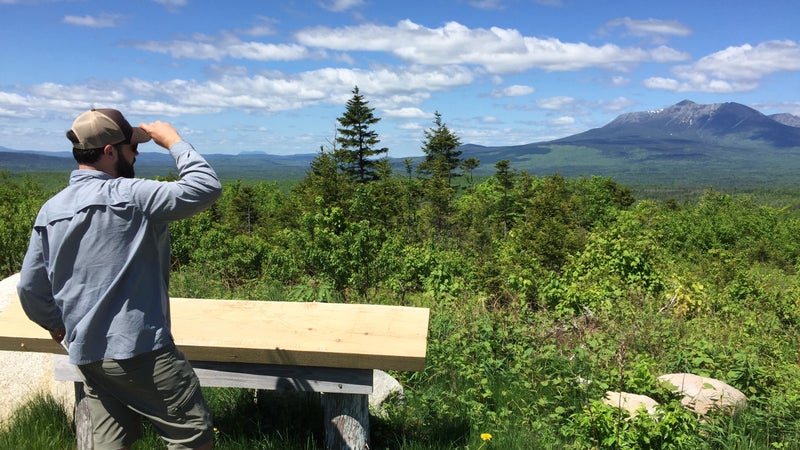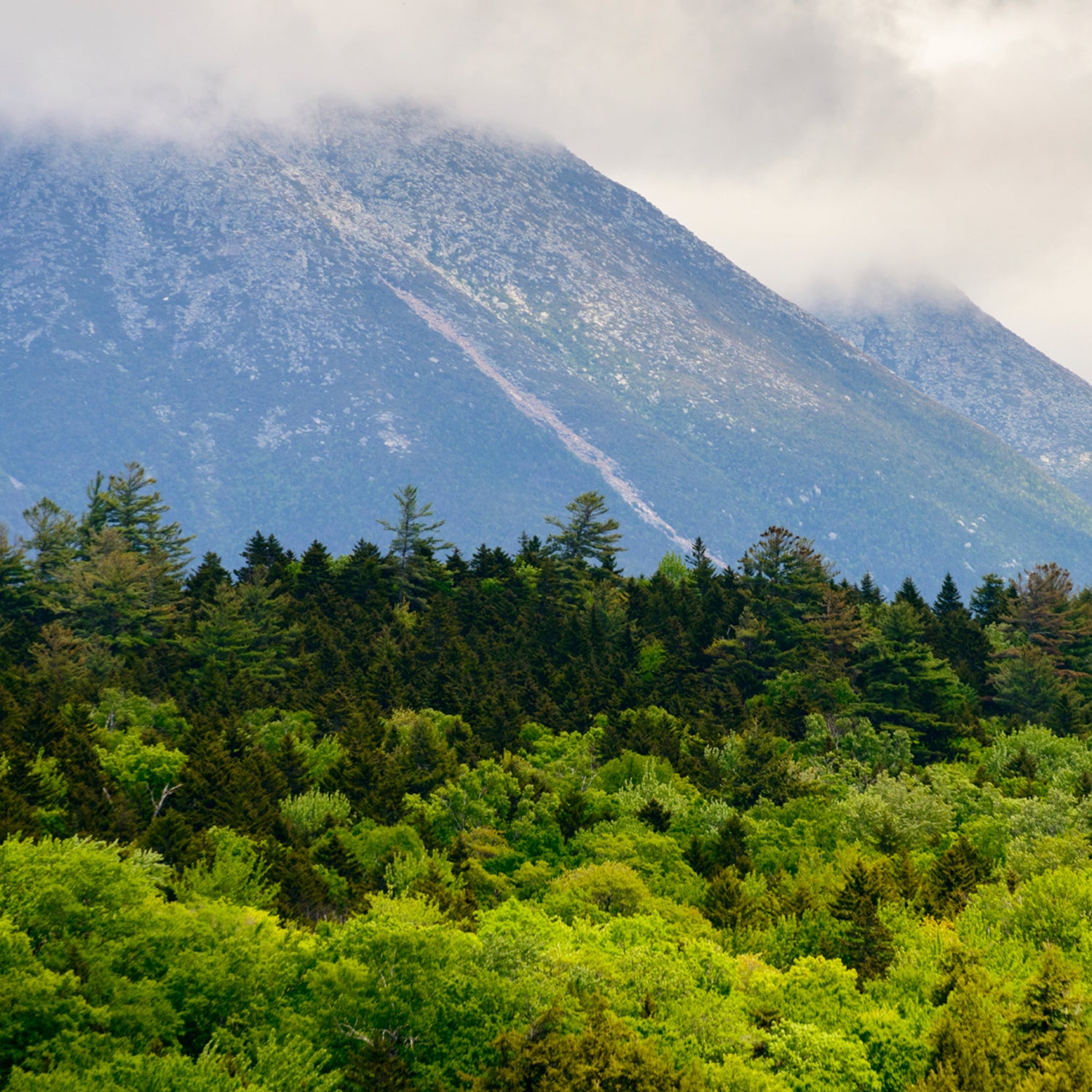Earlier this month I went on a hike through the woods in northern Maine with , a 38-year-old outdoorsman leading a monumental effort to establish a new national park on an 87,500-acre parcel of private land in the state. The area features��hikeable mountains, surging streams, trails littered with droppings from lynx, moose, and coyotes, and stunning views of Mount��Katahdin to the west, in Baxter State Park. It’s the place that made Henry David Thoreau exclaim, “In wildness is the preservation of the world.” It would make a spectacular 59th national park—if only St. Clair could find a way forward.
St. Clair, a bearded man standing six��feet five��inches��tall, is the perfect salesperson for the proposal: not only is he an avid environmentalist but he’s also a dedicated fisherman and hunter. Having grown up in nearby Guilford and earned a degree in culinary arts from Le Cordon Bleu in in Paris, he appeals to both snot-nosed college-grads and backwoods rednecks alike, having learned how to work just about any group thanks to ten years of working as a sommelier in Seattle.��
St. Clair inherited the battle to build a park four years ago from his mother, Roxanne Quimby, co-founder and owner of Burt’s Bees, who owns the land and had alienated many locals. One of her��early proposals, put forward in 2000 in cooperation with a group called��, proposed dedicating a much larger section—3.2 million acres, a chunk of land larger than Yellowstone and Yosemite combined.��The ginormous park, as it was proposed, would have absorbed the last 100 miles of the Appalachian Trail and Baxter State Park in the process, in addition to eliminating hunting, fishing, snowmobiling, and logging, a traditional cornerstone of the local economy. The area has supported hundreds, if not thousands, of lumber mills over the years and, at its peak in the early 1900s, more than 100 paper mills.

Quimby cut ties with RESTORE in 2004—the group wasn’t moving quickly enough for her liking—and ditched the mega-park plan, while continuing to buy up property from the ailing timber industry. But by then she had provoked strong resentment from many locals who felt the park plan would jeopardize their lifestyle and livelihoods. They attacked her plan, as well as her being a woman and an outsider—or in local parlance, “from away.” (Quimby also undermined her own efforts with in which she blasted rural Mainers for their obesity and addiction to oxycontin, and said they were hooked on welfare.)
Over the past 20 years, Quimby has sunk $74 million of her own money into the project. In 2006, she even added a sweetener: a $40 million endowment. And since St. Clair has inherited the project, he's worked (mostly successfully)��to mend fences with locals that felt ignored by��Quimby.��Setting the land aside, you’d think, would be a no-brainer.
“The land in the North Woods area proposed for donation absolutely fits the National Park Service’s criteria for national park sites, including suitability, feasibility, and national significance,” Park Service director Jonathan Jarvis declared during a visit to East Millinocket in May. “There is no other representative landscape like the North Woods in the national park system.”
And yet, in many ways, the plan to hand over this land to the federal government has been a case study in how seemingly impossible it is to create a new national park.
The process of converting government or privately owned land into a national park is a long and tedious one that makes Sisyphus’s task seem manageable by comparison.
The process of converting government or privately owned land into a national park is long and tedious—it��makes Sisyphus’s task seem manageable by comparison. For example, it took John D. Rockefeller to his proposal to donate a key piece of the��land for what we now call Grand Teton National Park. The��first step to becoming an NPS Unit—the categorical term for the more than 400 national rivers, lakes, structures, monuments, historic parks, and parks that the Park Service oversees—requires an act of Congress.��
Federal lawmakers must first enact a law requiring the Park Service to perform a feasibility study looking at the site’s cultural, historical, and environmental significance, as well as management options. (There's a three-year deadline for completing the study, though it is��almost always pushed back.) Generally, the areas being evaluated come at the recommendation of the president via the Department of the Interior. Since there are so many areas that have been nominated to be studied over the years—and there is a backlog—the Park Service prioritizes them using a points system, and submits only the highest ranking areas to the House and Senate in the form of a bill. Only when it passes through both houses can a new national park—or river, battlefield, trail, or the like—be born.
Since 2000, the White House has submitted dozens of areas for study—all under the Obama administration. Former President George W. Bush, unwavering on land protection, did not submit any study areas, although he did create three national marine monuments covering 125 million acres of the Pacific at the tail end of his tenure. During Obama’s tenure, dozens of units have been created, including 23 monuments and two parks: Pinnacles, a mountainous area in Northern California’s Central Valley, in 2013, and��Congaree, a large swath of old growth forest in South Carolina, in 2003.
The two parks are 2,500 miles apart, but they have one thing in common: both were initially national monuments. Quimby and St. Clair hope to follow that same path to parkhood—it may be��the only way around the Byzantine system.
“It is the perfect solution: less than a park, but still protected, “ Quimby explained in Eco Barons: The New Heroes of Environmental Activism. “And once it’s there and people find they can live with it, enjoy it and prosper because of it, then turning it into a park becomes no big deal. That’s what I’m gunning for. And that’s what will save the Maine Woods.”
During my recent hike with St. Clair to the proposed monument site, we followed a leafy, switchback trail up the 1,600-foot Mount Barnard, one of the property’s many small mountains. St. Clair and Quimby spend around $100,000 a year maintaining the land, and had the trail built in part to help show the land’s potential.
St. Clair hovered curiously over animal signs and, about halfway up the 30-minute hike, he halted to point out the change in environmental zones, evidenced by a nearly straight-line switch from hardwoods to pines. “This is what it’s all about,” he said over his shoulder, returning to his fast-paced hike. “Not all those meetings down in town.”��
St. Clair has spent the last few years attempting to win over more locals while also running operations to make the land look more Park-worthy. He’s commissioned stylish maps of the attractions, put up road signs that mimic NPS signage, and erected lean-tos for Appalachian Trail thru-hikers. “We figured if it looks like a duck, walks like a duck, then…” St. Clair explained with a shrug.
At the top of Mt. Barnard, a wide area strewn with tall boulders and low-lying trees, we sat at a new picnic bench built on the summit’s western edge, marveling at yet another breath-taking view of Katahdin. We could easily see the entire 100-Mile Wilderness series of mountains, but Katahdin, and the valley before it, stole the show.��
St. Clair only recently has begun making headway, but support has been swift: polls show 67 percent of Mainers now��favor a national park designation. Democratic Congresswoman Chellie Pingree��penned a note to Obama in May 2016 asking him to grant the area monument status. “It’s beautiful land, the majority of Mainers are for it, and Acadia has shown that a national park is financially beneficial for Maine,” Pingree says. The endowment is another selling��point and, “to my knowledge hasn’t happened in the history of the Park Service,” she adds.
But some of the locals’ initial concerns have carried over to the monument proposal,��and not all conservative lawmakers are excited. Republican U.S.��Senator Susan Collins, of Maine, has��.*��Maine’s Tea Party Republican Governor Paul LePage��says the presidential ability to award monument status is an abuse of power. “I don’t think it’s right for this president or any president to come up to our state or any other state in the country and say this is now federal land,” LePage recently declared in reaction to Jarvis’s comments. Republican Congressman Bruce Poliquin, who represents the district where the monument would be located, is opposed as well.��
LePage also argues that the designation would bar off valuable resources and undercut the wellbeing of people dependent on the timber trade. But the fact is that all of the paper mills in the Katahdin area have closed, their sulking metallic hulks a sad reminder of more financially prosperous times. But the land in question is, of course, private and already off limits to consumptive uses. Furthermore, economic impact studies commissioned by Quimby and St. Clair show that a monument could create at least 450 private-sector��jobs—a much-needed boost in a severely depressed regional economy.
As we head back down the wending trail from Mount Barnard’s summit, St. Clair seems more than a bit dismayed. I ask why he bothers, and he pauses. “I think so many people are losing the essential contact with nature,” St. Clair says. “We need to create as many opportunities for them to get outside as possible. And I think National Parks sites are the best and safest way to do that.”
The North Woods is beautiful land, worthy of becoming a monument and even a park. Whether it will ever happen is anyone's guess. To gaze out across the forested valley between Mount Barnard and��Mount Katahdin��is to ponder a mystifying question: We love our national parks; why don't we love creating new ones?
��


